Once it was the capital of the GDR – Berlin. Today, the reunited city without the wall is once again the capital and seat of government of Germany. However, Berlin still has many reminders of the GDR. After all, after the Second World War, many things were rebuilt in East Berlin by the GDR authorities. Thus, you will not only find buildings of Soviet-inspired neoclassicism in Berlin architecture, which was also pushed in the GDR until the death of dictator Josef Stalin. Alexanderplatz is home to some of the most beautiful buildings of GDR modernism. And sometimes there are also brutalist buildings or even buildings built by architects from other Eastern Bloc countries. Let’s go on the DDR Berlin walking tour!
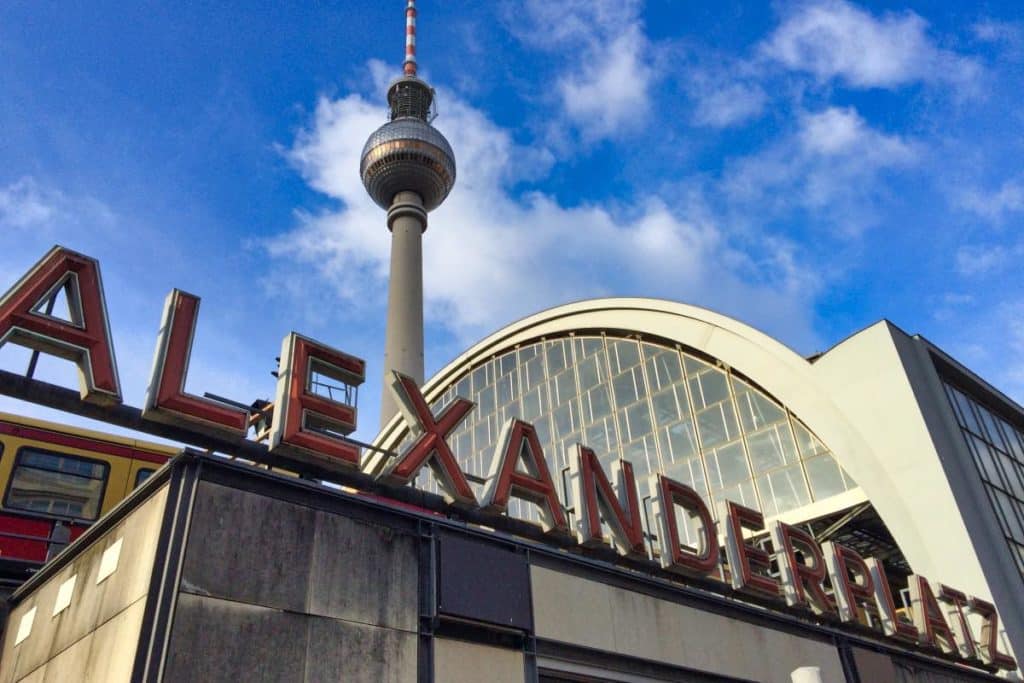
Alexanderplatz
It is probably the square par excellence for anyone who thinks of GDR architecture – Alexanderplatz. Here, the GDR leadership wanted to show itself internationally and prove with the buildings that it was in no way inferior to the FRG in its development. And indeed, with the modernist buildings on the Alex, one might well get the idea that the GDR was very progressive.
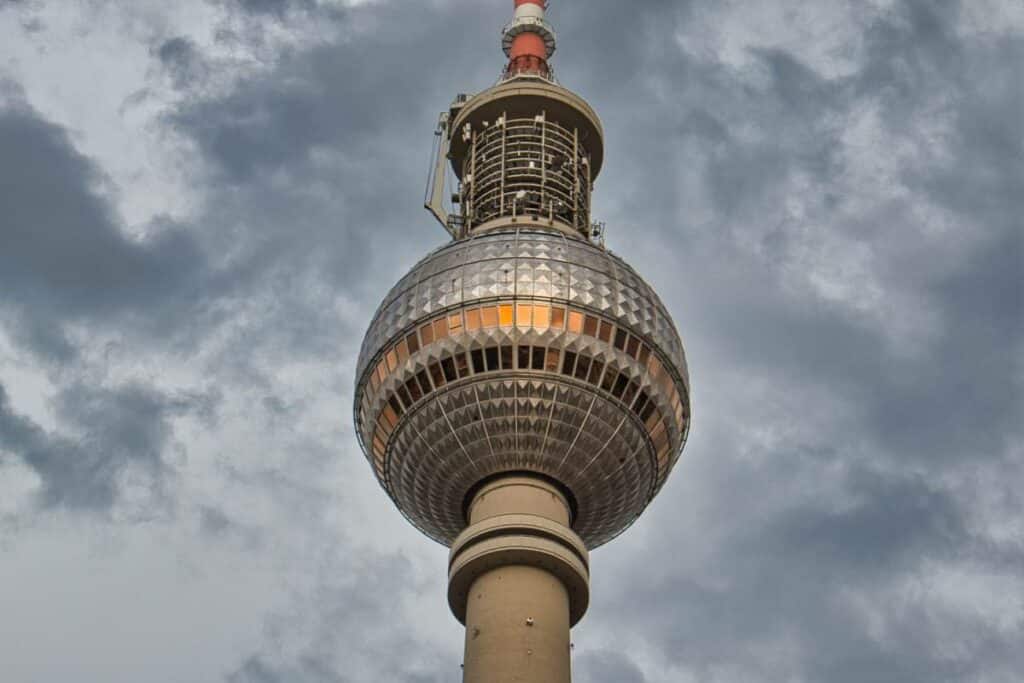
Fernsehturm
Today, the TV tower Fernsehturm, built as a landmark of East Berlin, is the most famous sight in all of Berlin. In the souvenir stores of the city, the towers are just lined up. The Berliners named the technical masterpiece “Telespargel” (TV Asparagus). At 368 meters, the Berlin TV Tower is still the tallest building in Germany. It was designed between 1965 and 1969 according to plans by Hermann Henselmann, who also designed the Jena University building and parts of Karl-Marx-Allee. The viewing platform at 200 meters is visited by millions of guests every year. The restaurant below rotates once an hour, so you can see the whole city while sitting there.
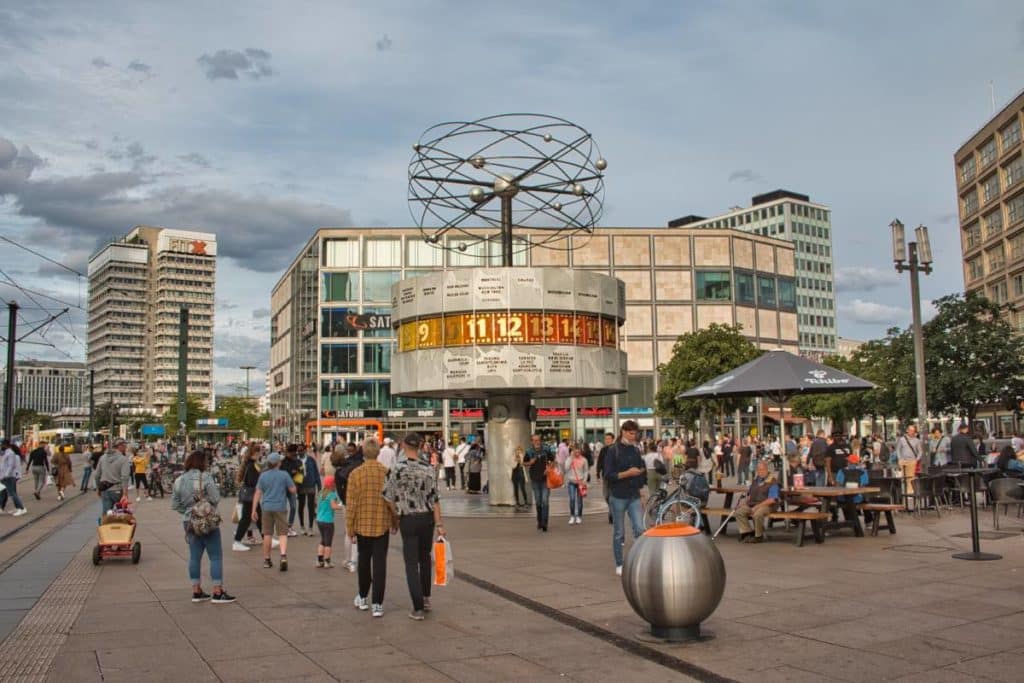
URANIA world time clock
The world time clock is located directly on Alexanderplatz. However, it not only shows the time of a total of 148 cities worldwide, but is also the most popular meeting place in Berlin. It is almost a tradition to meet at this East Berlin architecture landmark. It was designed by Erich John. By the way, he also designed microscopes and a typewriter.
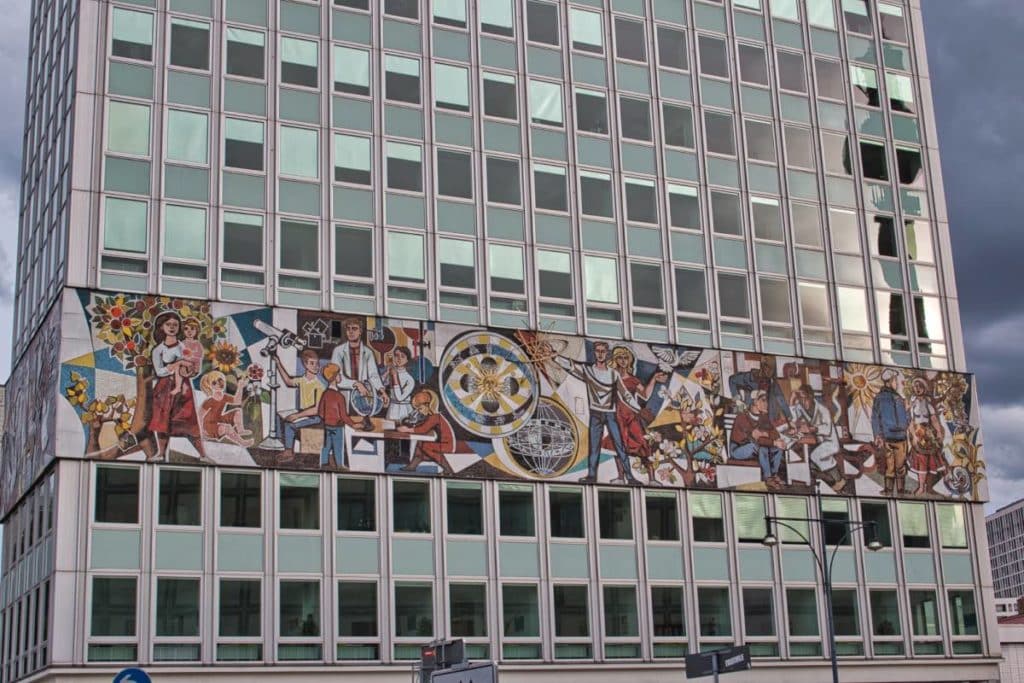
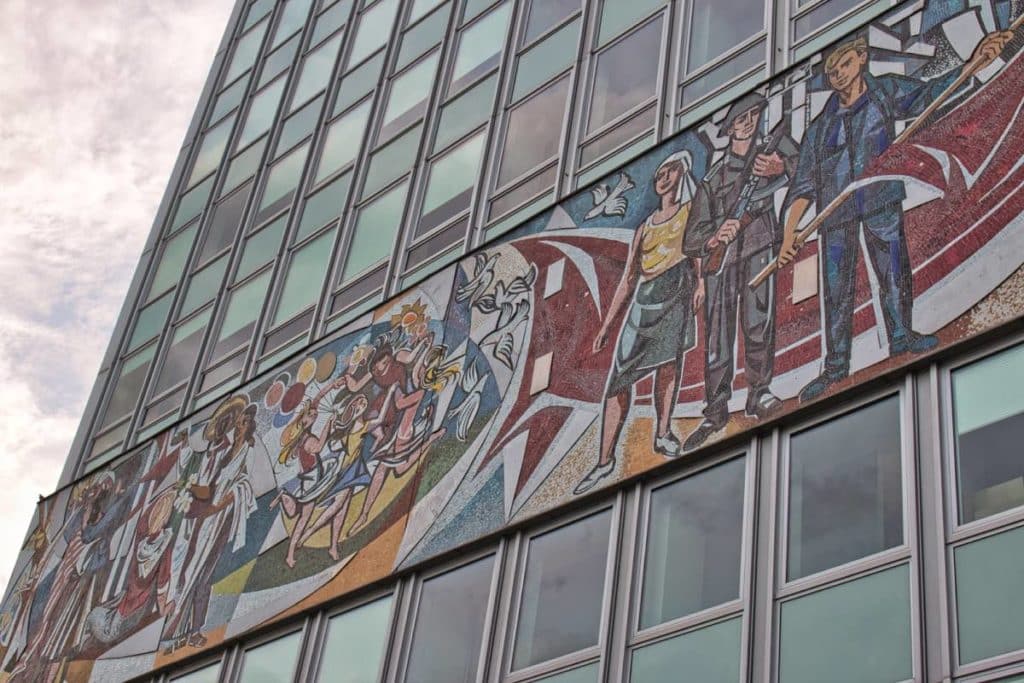
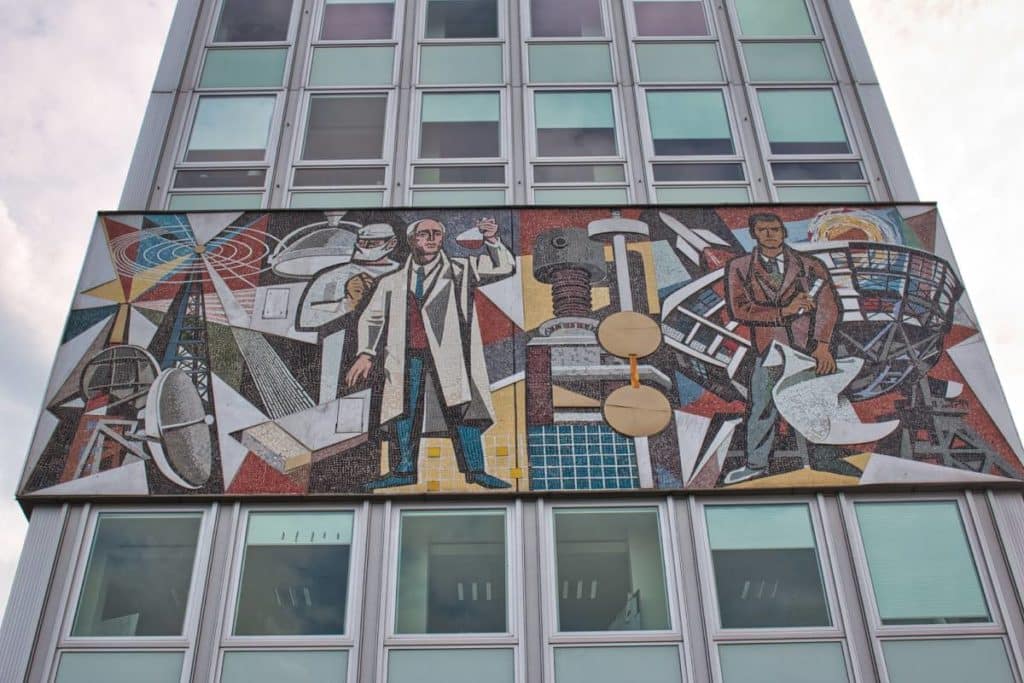
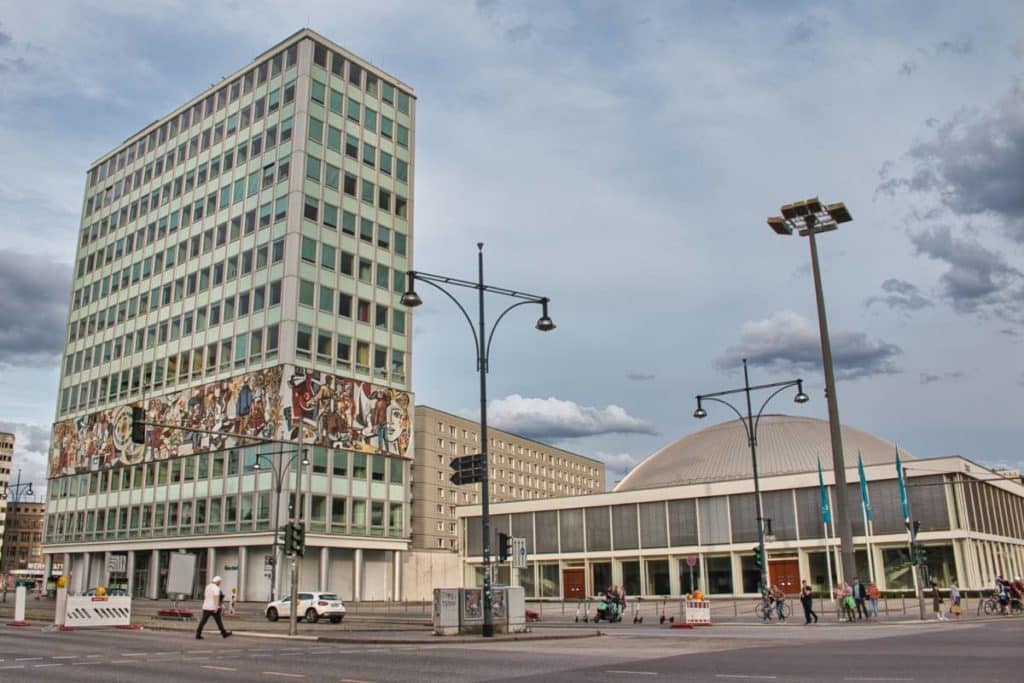
House of the teacher and congress hall
The Haus des Lehrers (House of the Teacher) was the first high-rise building that the city planners implemented in the course of the redesign of Alexanderplatz from 1961 to 1964. At 54 meters, it is not the tallest of the skyscrapers here. However, the design with the tile mosaic makes it the most beautiful. The mural was designed by Walter Womacka, who was an art professor at the Weißensee Art Academy. Until the opening of the Palace of the Republic in 1976, the People’s Chamber of the GDR met in the Congress Hall.
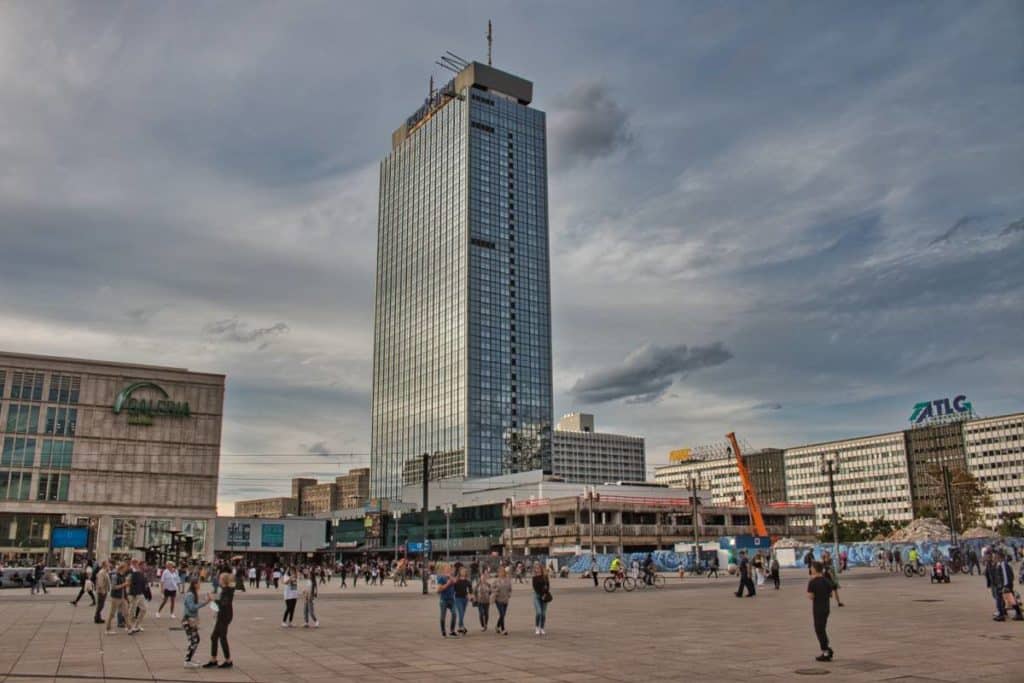
Panorama Hotel
The Interhotel Stadt Berlin was the most important hotel on Alexanderplatz. With 125 meters it was even the highest house in Berlin until 1998. It was opened in 1970, on October 7 – the founding day of the GDR. The hotel offered 1006 rooms and was thus one of the largest hotels in the GDR. Delegations from the brother states of the Warsaw Pact were often accommodated here.
Centrum department store
The Centrum department store was opened right next to the hotel. It was the largest department store in the GDR. When empty shelves often prevailed elsewhere, everything was sold here on 15,000m². The characteristic honeycomb facade of the building still existed until the 2000s, but was then removed by the owner Galeria Kaufhof as part of a redevelopment. Today, like the Berolina-Haus, the facade is more reminiscent of the buildings of the 1920s.
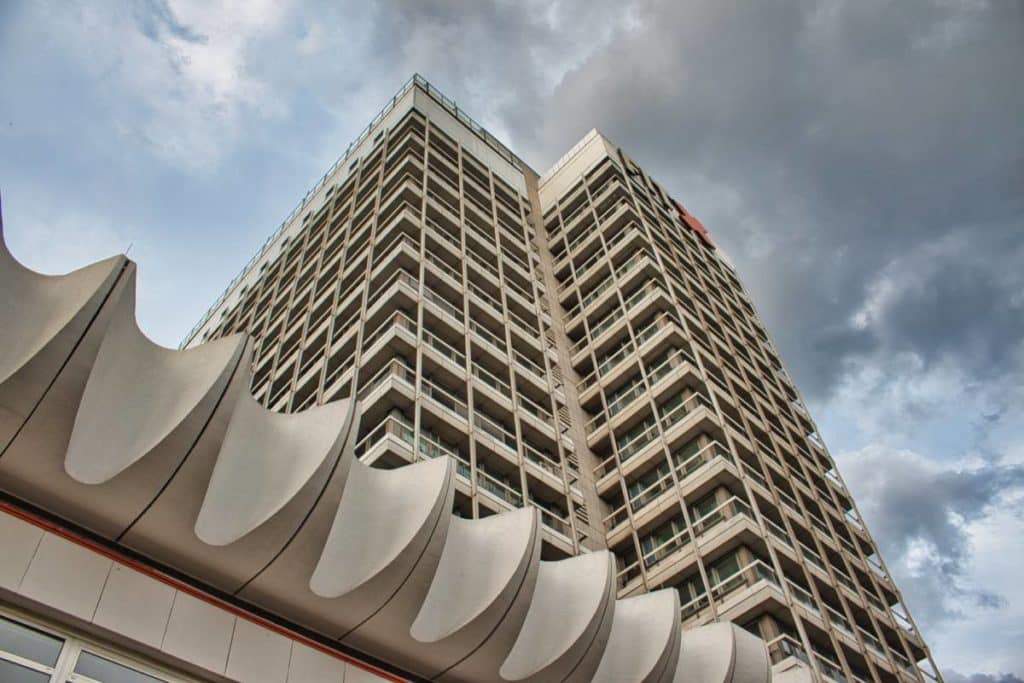

House of travel
The Haus des Reisens, on the other hand, is a classic of New Objectivity. It was opened in 1971 as one of the last buildings on Alexanderplatz. Both the GDR’s state travel agency and the GDR airline Interflug were based here. Since the fall of the Berlin Wall, there have been several discussions about the building. Today, the top floors are home to Club Weekend with a rooftop terrace. On the side of the building is the copper relief called “Man Overcomes Time and Space”, also by Walter Womacka.
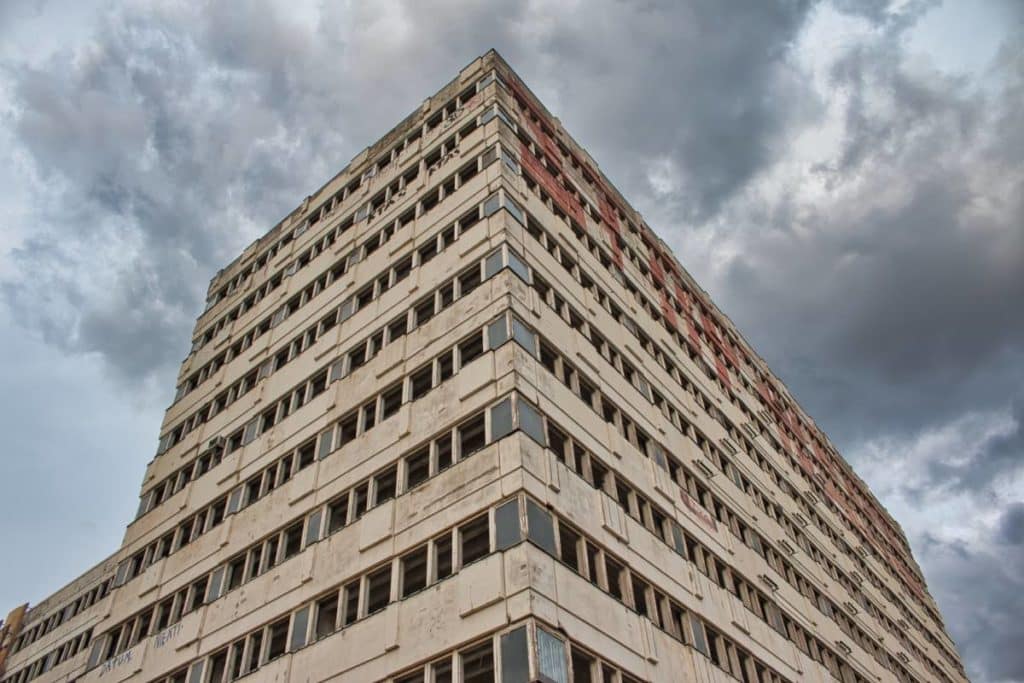
House of statistics with mocha cup
Opened in 1970, the building was the seat of the State Central Statistical Administration of the GDR. There were two restaurants in the building. The House of Statistics also had some works of art. In addition to a giant mocha cup advertising the Café Mokka-Eck, the five-part architectural sculpture “The History of Mathematics” by Karl Hillert was on display here. Today it can be found in the courtyard of the Federal Ministry of Labor and Social Affairs. In front of the Suhler Jagdhütte hunting store, a steel sculpture by Achim Kühn depicting birds adorned the facade. Inside the building hung the mural Praise of Communism by Ronald Paris. It is now in the collection of the GDR Museum.
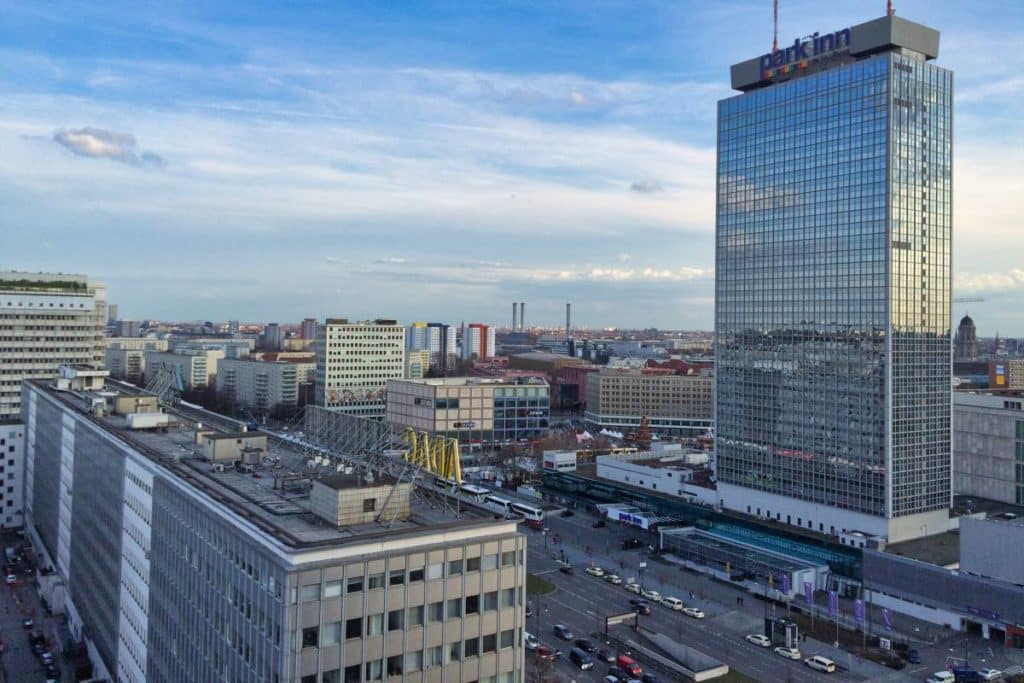
House of the Electrical
Opened in 1969, the House of the Electrical Industry closed off Alexanderplatz between the House of Travel and the Berlin Publishing House. The GDR’s Ministry of Electrical Engineering and Electronics had its headquarters here. There were several public stores in the house where GDR products could be purchased. One store sold records of the GDR companies Eterna, Amiga and Litera. In the radio and television store there were televisions and radios. Watches from Ruhla, Glashütte and Weimar were also sold. And in the photo-cinema-optics store there were mainly products of the Carl-Zeiss factory in Jena.
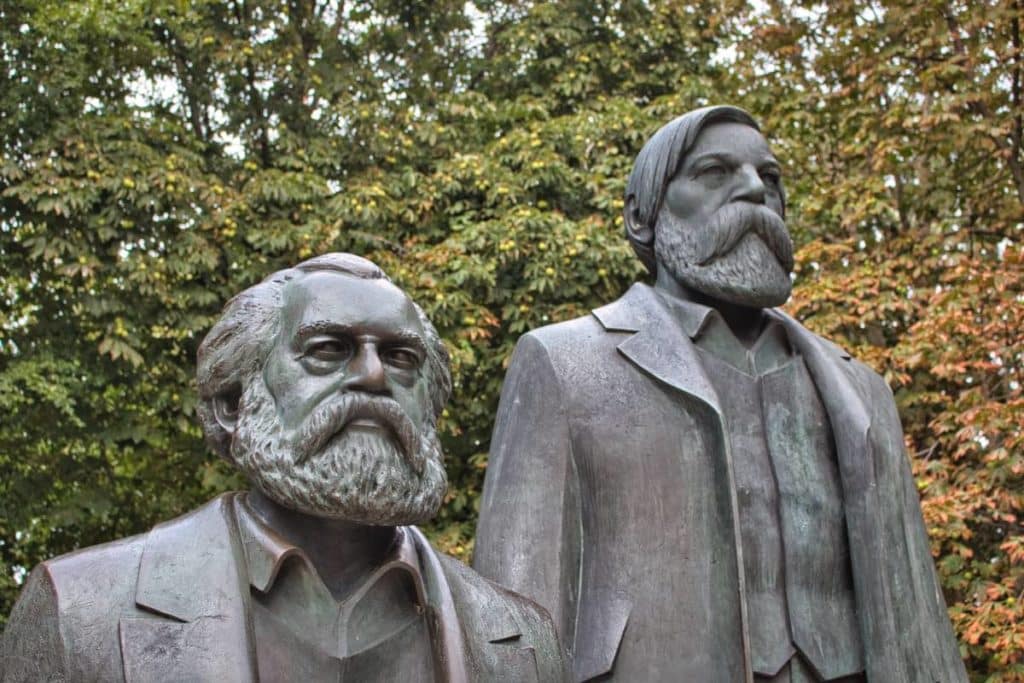
Marx Engels Forum
Seen today, the sculptures of Karl Marx and Friedrich Engels seem almost lost. And somehow they are. When the Marx-Engels Forum was inaugurated as a park not far from Alexanderplatz in 1986, the GDR was already almost history. And so the monument has stood in free Berlin almost ten times as long as it did in the GDR. After all, Berliners did not personally resent the GDR for the forefathers of communism. In 1991, the monument’s pedestal was emblazoned with the words, “We are innocent.” Fair enough. Then I guess they can stay.
Karl-Marx-Allee
It was a showpiece of the GDR government and a symbol to show that anti-fascist Germany had risen anew and better from the ruins of the Third Reich than its capitalist counterpart – Stalinallee. Named after the Soviet dictator, one of the GDR’s largest construction projects was built on the ruins of the old Frankfurter Allee. Today, the neoclassical buildings are among the most famous East Berlin architecture sights. Reason enough to introduce you to the Karl-Marx-Allee and its most beautiful buildings.

Café Moscow and mocha milk ice cream bar
The legendary mocha-milk ice cream bar right next to it, like the cinema, was built in the second construction phase from 1961 to 1964 and was one of five pavilions in the avenue. The yellow-tiled building is worth seeing, as is Café Moskau with its characteristic honeycomb struts and the mosaic “From the Life of the Peoples of the Soviet Union.” Funny detail: the full-size Sputnik satellite, a gift from the Soviet ambassador.
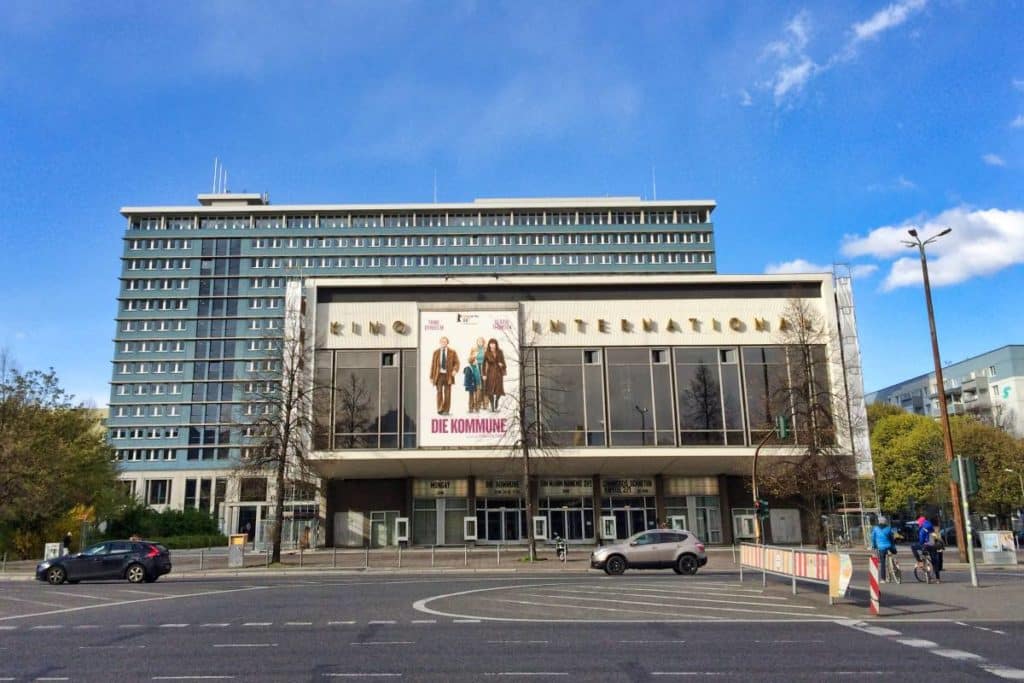
Kino International
Kino International (International Cinema) was once the largest and most modern cinema in the country. Today, film premieres are still held here. The building is particularly exciting because it is representative of the buildings of the third construction phase, i.e. modernism, and its canopy, which is well worth seeing, still delights architecture fans.
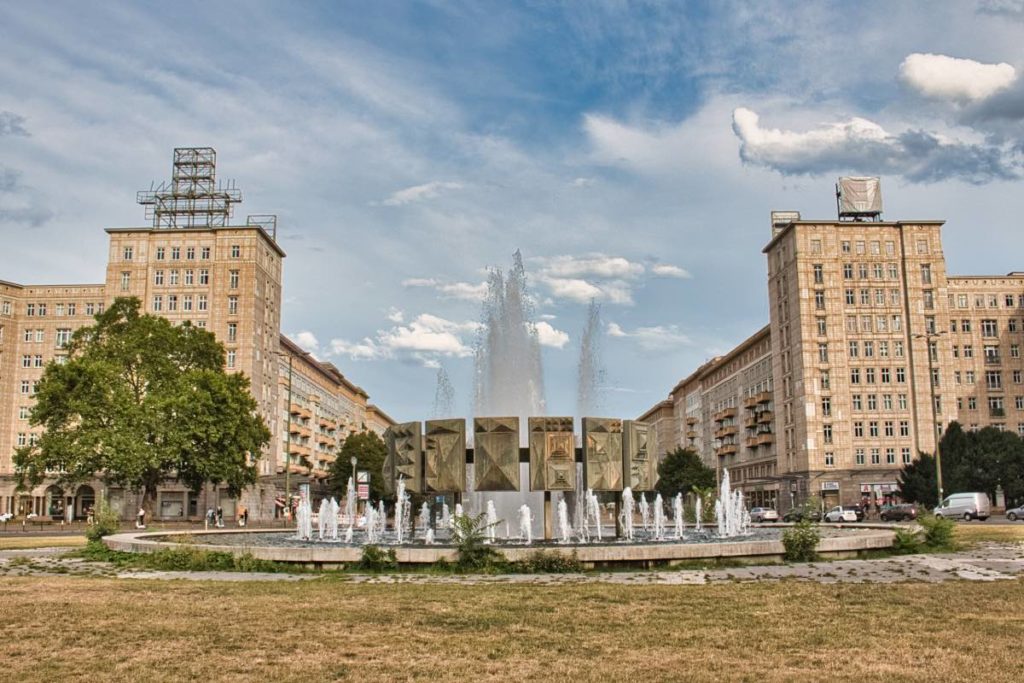
Strausberger square with fountain
Strausberger Platz (square) marks the transition of the districts of Mitte and Friedrichshain-Kreuzberg. It is the only “real” square on Karl Marx-Alle and has an oval area with an impressive fountain in its center. Since 1966, several fountains have surrounded a circular framework of eight pillars with rectangular copper plates here. The water haze makes it seem as if the work of art is floating in the air. We think that Fritz Kühn’s fountain, in combination with the houses on Karl-Marx-Allee, is one of the best photo motifs on the street. Here at the square there is also a bust in honor of Karl Marx. You can find more information about Karl-Marx-Allee in our article about the street.
Around Unter den Linden
Unter den Linden (“Under the Linden trees”) was above all the boulevard of the Prussian kings. But the GDR also made the street its own. After all, it was not only the famous Humboldt University that stood here. The Palace of the Republic (Palast der Republik) was also built here in place of the former City Palace. In the meantime, the City Palace is being rebuilt and the Palace of the Republic is history. It’s a pity, because we could devote an entire article to it.
Council of State Building (Staatsratsgebäude)
This peace of Berlin architecture was extremely unusual for a GDR government building. Without further ado, the planners integrated the Eosander portal from the Berlin City Palace into the front of the Council of State building. This classic portal was combined with a modernist building. Walter Ulbricht had his seat here from 1964, Willi Stoph (1973-1976) and Erich Honecker from 1976. In the building there is still a huge GDR coat of arms to see and also a large mural by Walter Womacka entitled “The History of the Workers’ Movement”.
Friedrichstraße station with Palace of Tears
In GDR times, Friedrichstraße station was the first, or depending on your point of view, the last stop on the Berlin Stadtbahn to West Berlin. Many visitors to the FRG arrived here. There were even interstores where users of the West Berlin S-Bahn could go without passing through the GDR border control. The GDR authorities had erected a functional building next door shortly after the Wall was built in order to have more space for border controls to exit the country. Here, West German visitors said goodbye to their GDR relatives and acquaintances. For this reason, the hall was also known as the Palace of Tears. Today it houses an exhibition about its history.
Friedrichstadtpalast
Friedrichstadtpalast is one of the outstanding examples of GDR postmodernism in Berlin architecture. Built between 1981 and 1984, the theater is an example that prefabricated buildings do not have to be ugly. After all, the building was also constructed from prefabricated reinforced concrete elements. It is extremely variable. In one or two minutes, an ice rink or a swimming pool can be integrated – during the shows. All the well-known artists of the GDR used to perform here, and tickets were sometimes sold out for months. Even today, the revue theater is popular and the shows attract thousands of visitors.
Czech embassy
Today’s Wilhelmstraße was formerly named after Otto Grotewohl, the first prime minister of the GDR. Wilhelmplatz, located roughly in the middle of this street, which is a good 2 km long, also used to have a different name and was called Thälmannplatz after a communist politician who was murdered by the Nazis. The area had been heavily destroyed during the war and it was only between 1974 and 1978 that a building was erected here, which became the seat of the Czechoslovak Embassy and today houses the Czech Embassy, one of the outstanding examples of Socialist Modernism.
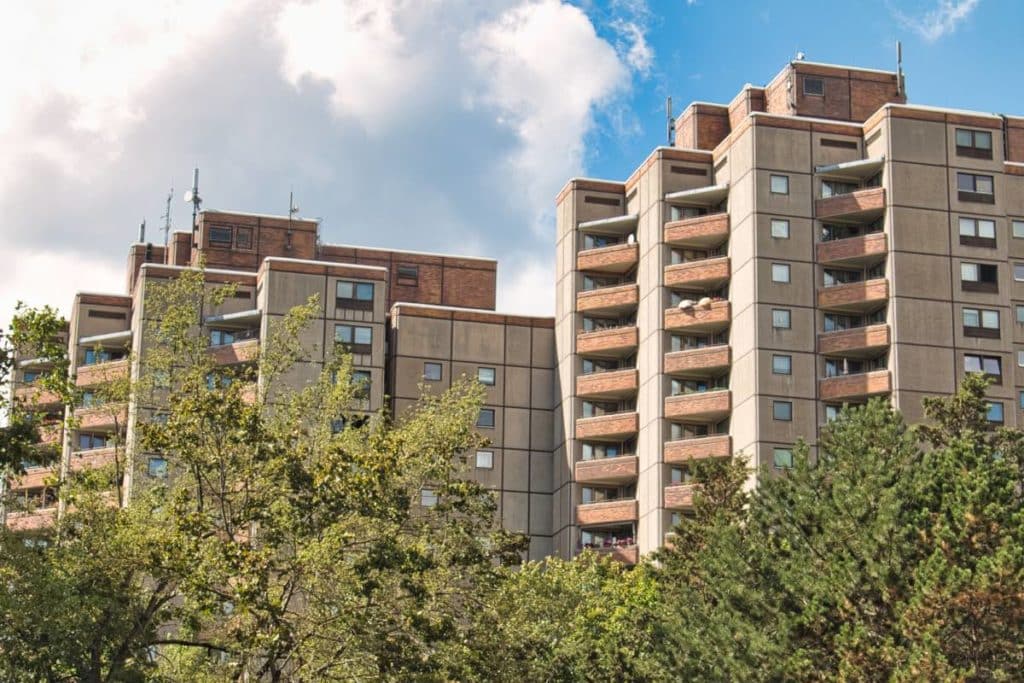
Ernst Thälmann Park
To mark the 100th birthday of Ernst Thälmann, the housing complex around Ernst Thälmann Park was built in 1986. Several 18-story buildings housed around 4,000 Berliners even then. There was also an indoor swimming pool.

Ernst Thälmann Monument
The high-rise residential buildings provide a perfect backdrop for the Ernst Thälmann memorial. The communist leader, who was murdered in the Buchenwald concentration camp in 1945, is commemorated here with a 14-meter-high bust. It was designed by Lew Kerbel, who also designed the bust of Karl Marx in the center of what was then Karl-Marx-Stadt.
Wabe (Honeycomb)
The Wabe was the first building in the quarter and served as a cultural center with a café. It was built in 1986 on the site of the former gas works. Parts of the administration are still used by the cultural center today. A theater, youth workshops and a gallery are also based here.

Zeiss Planetarium
Anyone who sees the large planetarium at Thälmann Park could almost believe the promises of communism, especially with regard to the conquest of space. After all, the planetarium, which opened in 1987, looks like a space station on the moon. In the past, a Zeiss projector from Jena showed the stars of the universe. Today, there is an even better projector. At least they decided to leave the interior architecture in the original, so the visit is a real trip to GDR Berlin.
Berlin Wall and Places of the Peaceful Revolution
In 1989, the dissatisfaction of many citizens with “real existing socialism” was also strongly felt in Berlin. Even though Leipzig is considered the city of the Peaceful Revolution, the Wall fell in Berlin and the city was also, like no other, affected by the division of Germany.
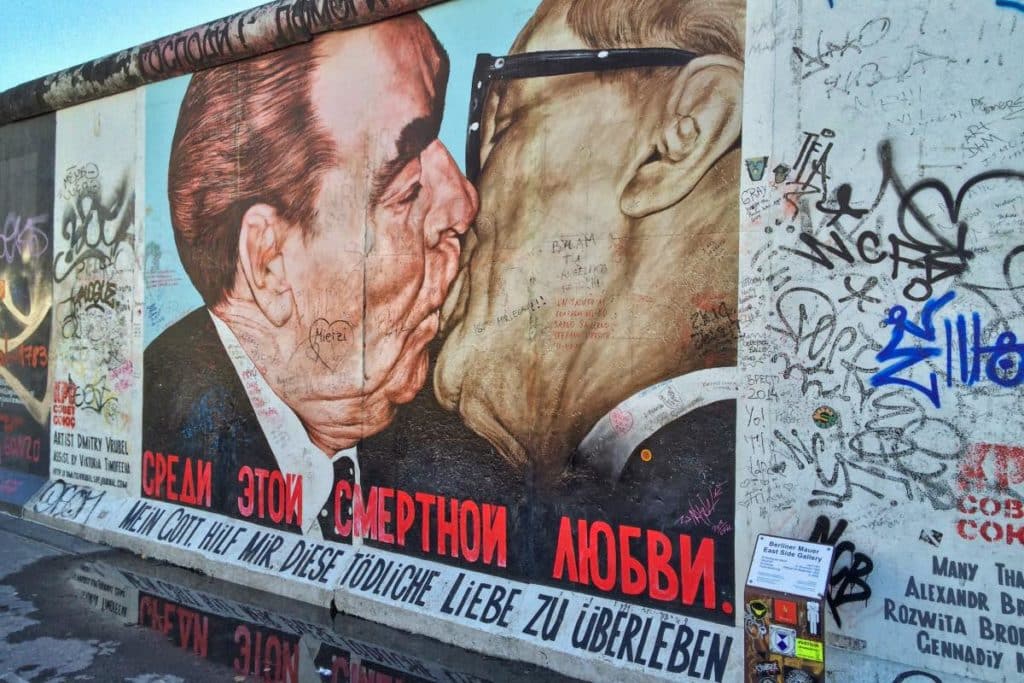
East Side Gallery
Not much is left of the Wall in Berlin – fortunately. The East Side Wall between Ostbahnhof and Oberbaumbrücke used to shield parts of Friedrichshain from neighboring Kreuzberg. In the spring of 1990, parts of the Wall were torn down. At the East Side Gallery, it was decided to invite artists and let them create something to mark this historic event. 118 artists from 21 countries came. The result was what is now the largest open-air gallery in the world. Some of the artworks today stand iconically not only for the East Side Gallery, but as advertisements for the city of Berlin. Among the most famous and beautiful works are Dmitri Wrubel’s “My God, Help Me Survive This Fatal Love,” featuring the brotherly kiss of Honecker and Brezhnev, and Birgit Kinder’s “Test the Best.”
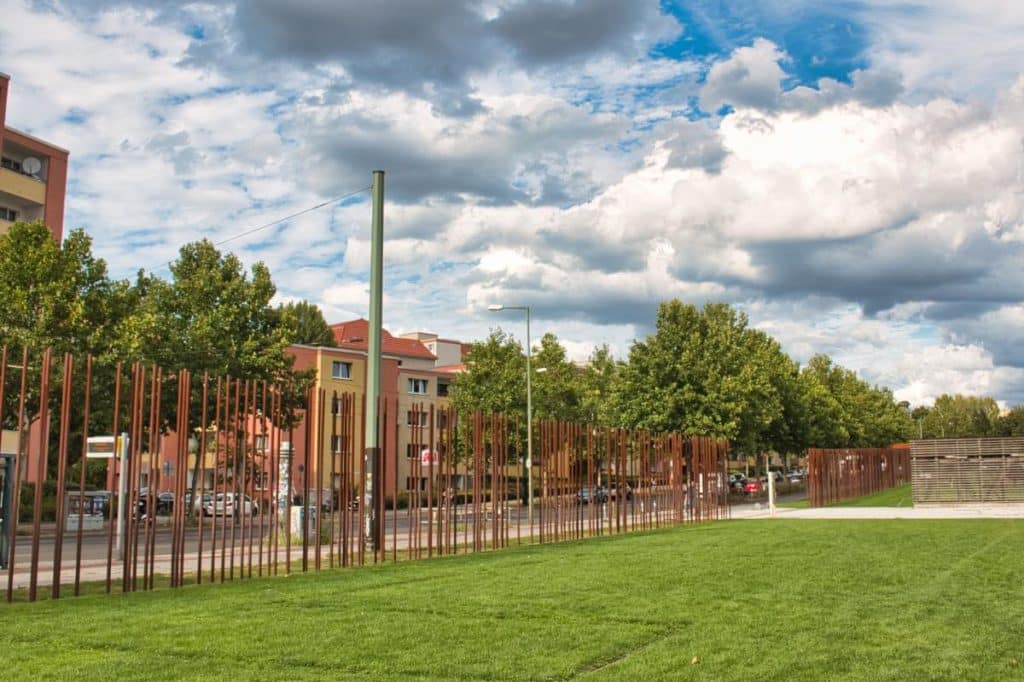
Berlin Wall Memorial
The Berlin Wall Memorial is one of the most important Berlin Wall sights today. In the open-air museum you can not only see remains of the Berlin Wall and a watchtower. There are display boards with a lot of information about the border wall and the death strip. There are also many pictures showing the Wall before it fell. Of particular interest, however, is the replica of the Wall with a work of art made of iron bars. Today you can jump back and forth between the two sides where the border guards of the GDR used to stand guard. There is also an interesting exhibition and a lookout point in the visitor center.

Gethsemane Church
As one of the churches in East Berlin, the Gethsemane Church is representative of the churches that served for vigils, peace prayers and as shelters for protesters during the Peaceful Revolution in Berlin as well. GDR opposition figures such as Marianne Birthler and Ulrike Poppe, among others, gathered here. During the protests against the 40th anniversary of the Republic on October 7, 1989, hundreds of people hid here, but were nevertheless arrested and imprisoned by the State Security and other police authorities.
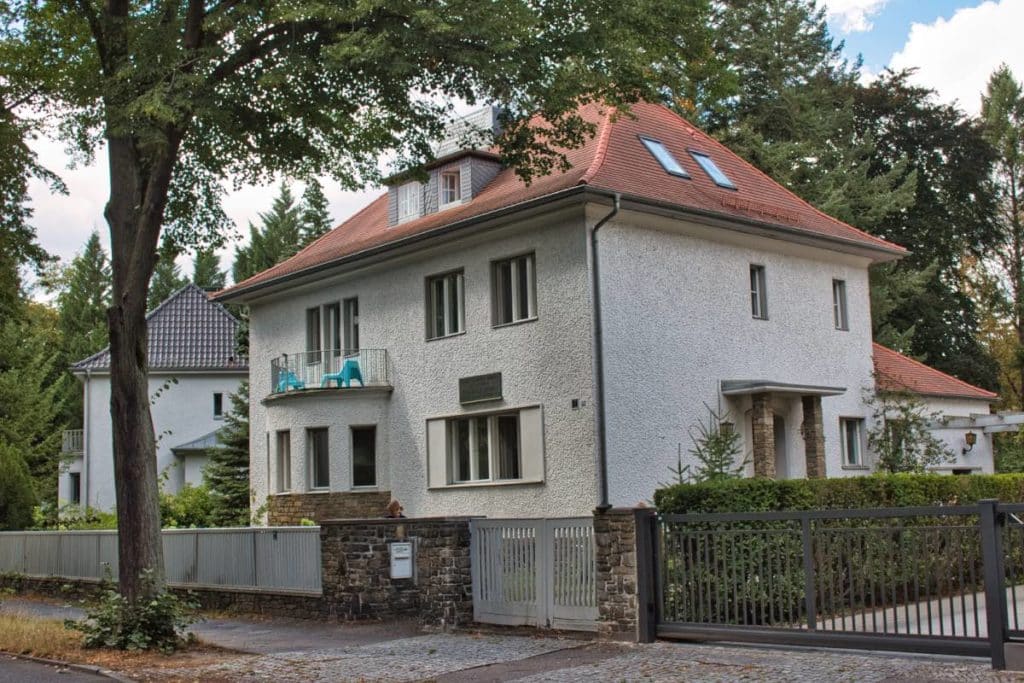
Majakowskiring – Housing for SED bigwigs
Until the construction of the Waldsiedlung in Wandlitz, Majakowskiring was something like the government district of the GDR, albeit in terms of apartments. A whole series of high GDR politicians lived in the quarter. For example, Walter Ulbricht (No. 28), Erich Honecker (No. 58 and Rudolf-Ditzen-Weg 14), Johannes R. Becher, the author of the GDR national anthem (No. 34), Otto Grotewohl (No. 46/48), Günter Schabowski, who accidentally opened the Wall (No. 63) and the chairman of the GDR Council of Ministers Willi Stoph (No. 64) resided here.
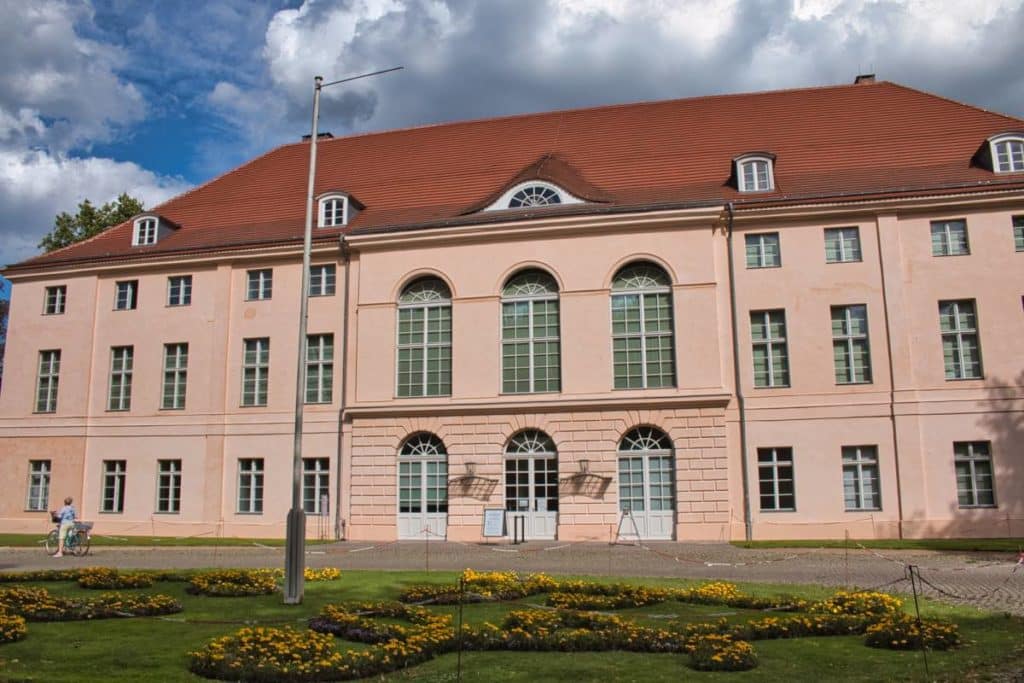
Schönhausen Castle
Schönhausen Castle has gone through an eventful history, especially in the GDR. Thus, the castle, which was renamed Niederschönhausen by the GDR authorities, served as the seat of the President of the GDR, Wilhelm Pieck, until his death in 1960. Subsequently, the State Council of the GDR met here until it moved to the State Council Building. It was then converted into a guest house for the GDR government, and high-ranking GDR visitors such as Indira Gandhi, Fidel Castro and Raisa and Mikhail Gorbachev stayed here. In the course of the fall of communism, the round tables between the GDR government and the opposition were held here and the Two-plus-Four Treaty was signed here. It cleared the way for reunification.
GDR media in Berlin
As the capital of the GDR, the GDR’s most important media cooperations were of course also based in Berlin. They held prominent positions in the cultural landscape, were also comparatively well funded as propaganda organs and had prestigious buildings at their disposal.
Neues Deutschland
Neues Deutschland was the central organ of the SED. Here, all important decisions of the GDR government were announced and it was vigorously agitated against “Western imperialism”. The ND, as the newspaper was also called for short, still exists today. However, it does not have a circulation of millions. It is a left-wing daily that is no longer officially affiliated with the successor party to the SED Die Linke. And something else hasn’t changed either: the address. To this day, ND is located at Franz-Mehring-Platz 1 (until recently with the Rosa Luxemburg Foundation, which is also close to the Left). The door handles with the letters ND still bear witness to this.
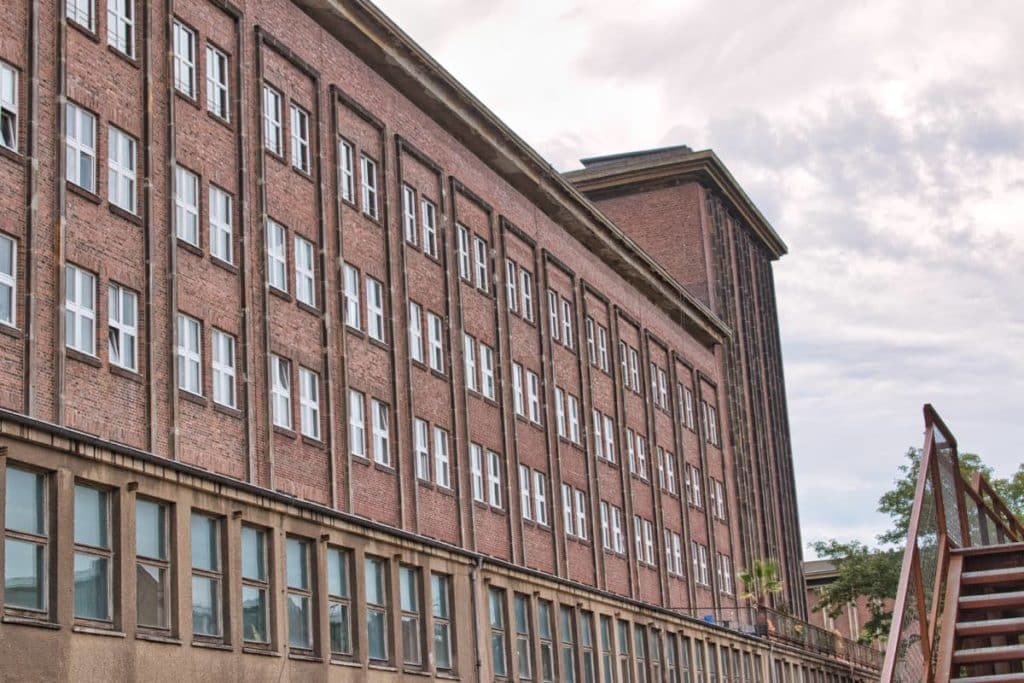

DDR Broadcasting Studios Nalepastraße with milk bar
Once the house of Bauhaus student Franz Ehrlich was the headquarters of the GDR radio stations DDR1 and 2 as well as the famous youth station DT64. Concerts were recorded in the radio halls. This is still the case today. In addition, dozens of bands were present here, renting rehearsal rooms. In the milk bar there are delicious snacks. Only the coffee is definitely better than in GDR times. Guided tours of the grounds are offered every weekend and should be reserved in advance. It’s worth it!
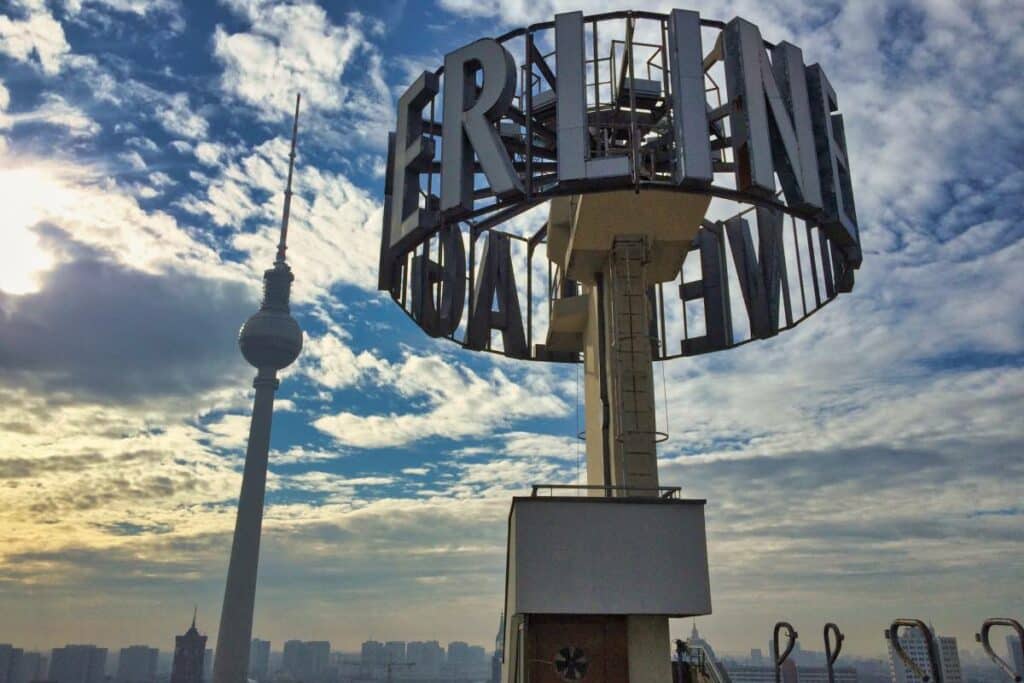
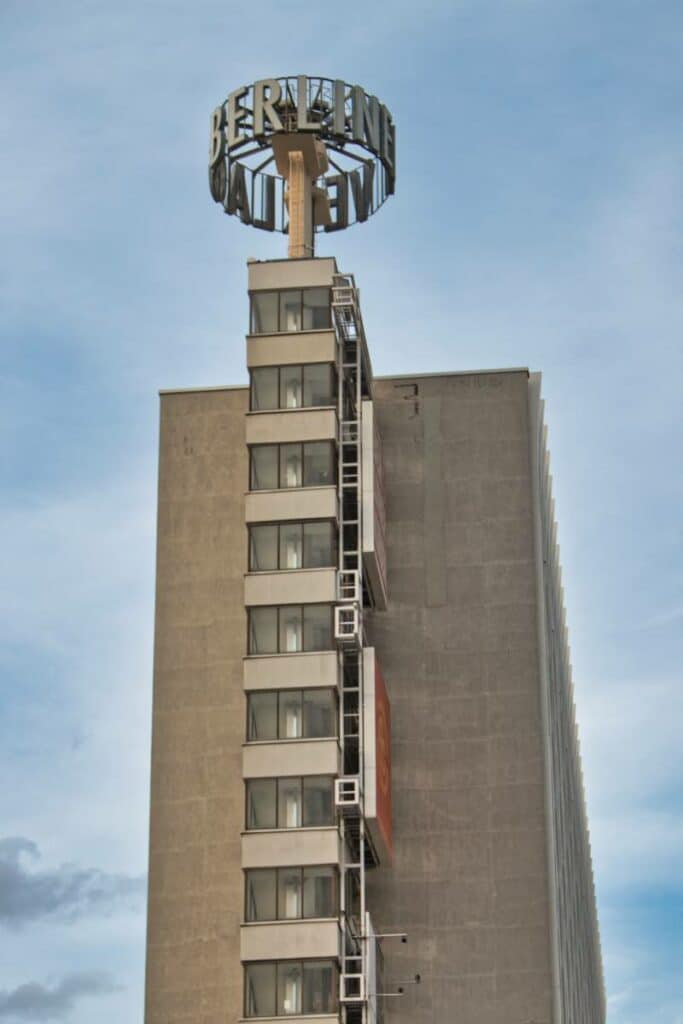
House of the Berlin Publishing House
In GDR times, the most important local and regional media of East Berlin were located in the building of the Berlin publishing house. It was built from 1970 to 1973 almost at the same time as the ND building and was intended to be the counterpart to the Springer Tower in West Berlin. Among other things, the editorial offices of the Berliner Zeitung and the BZ am Abend (today Berliner Kurier) as well as the Neue Berliner Illustrierte were based here. The 16-story building offers a fantastic view over the city. I know this, I once worked here myself on the 15th floor. The building’s landmark is also the rotating Berlin sign on the roof.
Recreational facilities in Berlin architecture
Of course, the GDR also wanted to offer its citizens leisure opportunities that would provide recreation and distraction. In Berlin, there were not only many playgrounds, parks and sports facilities. Large, central recreational places had also been created and built for the citizens of the capital of the GDR.
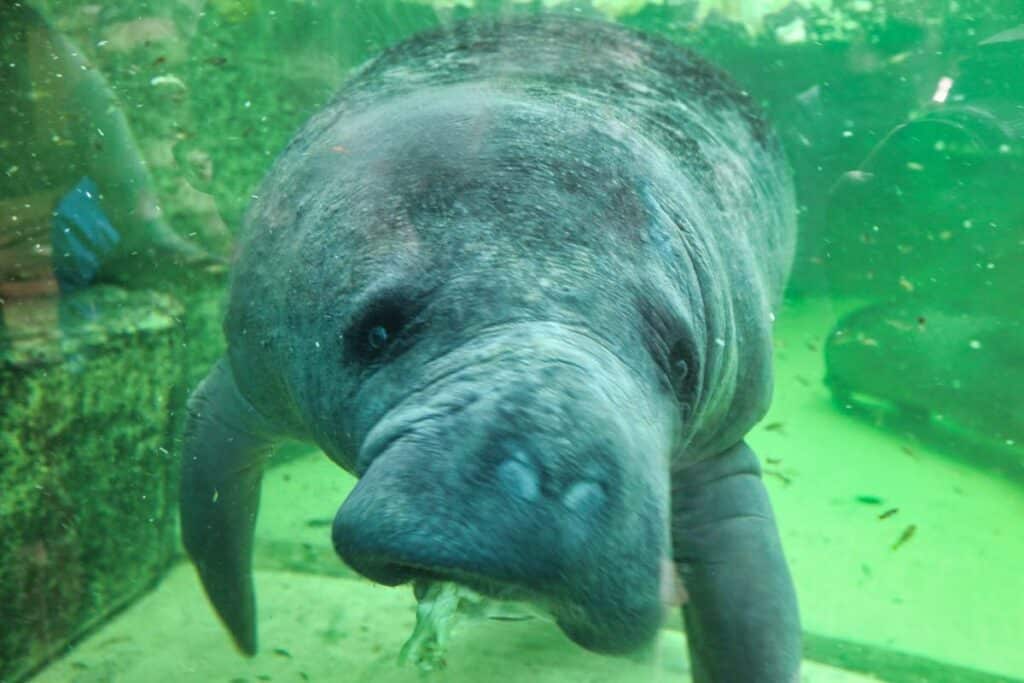
Tierpark
The Tierpark zoo was probably the most popular leisure facility in East Berlin – and still is today. Opened in 1955 by Wilhelm Pieck and Walter Ulbricht, there were thousands of exotic animal species to see here. For GDR citizens, the zoo was a window into the colorful world behind the Berlin Wall. It is still one of the best zoos in Germany, Europe’s largest landscape animal park and a stark contrast to the Berlin Zoo, which is quite cramped in the middle of West Berlin. To this day, there are some species of animals to see here that are rarely seen elsewhere. My favorite: manatees!


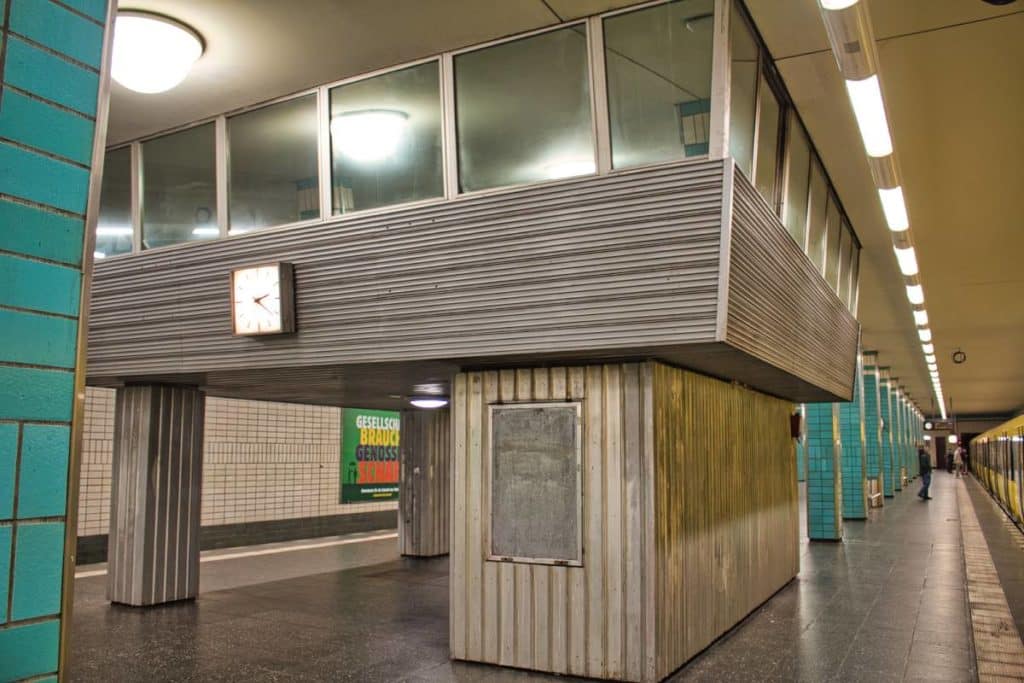
Tierpark subway station
If you should go to the Tierpark, then you probably use U5 line. The subway station Tierpark still looks the same as in GDR times and has not yet been renovated. Particularly nice: the guardhouse in the middle of the platform.

Pionierpalast Ernst Thälmann
In former times the FEZ was part of the “Pioneer republic Ernst Thälmann”. In 1979, the “Pioneer Palace” was built here, which is the largest children’s and youth center in Europe with 15,000m². There are several theaters, an indoor swimming pool, sports facilities, a space center and much more. To this day, the site is visited by many Berliners.
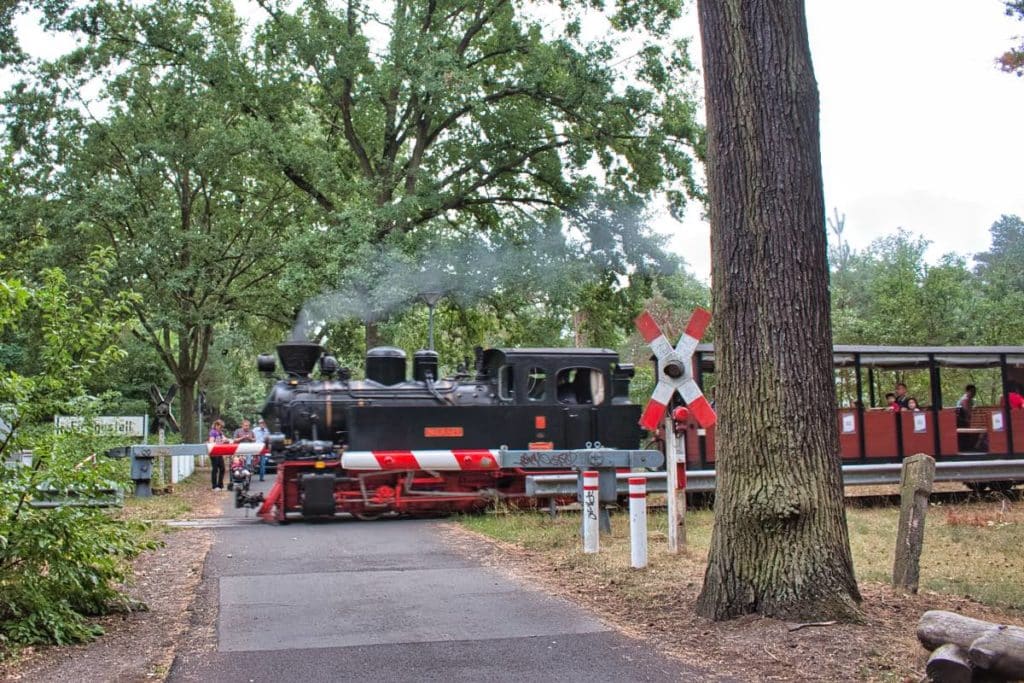
Pioneer Railway Wuhlheide
The Wuhlheide park railroad is also part of the site. As in other pioneer railroads from the GDR era, young volunteers take over all tasks here, except for driving the locomotive. The route is 7.5 kilometers long and from the S-Bahn Wuhlheide you can transfer directly to the park railroad. There are five stations to this day.
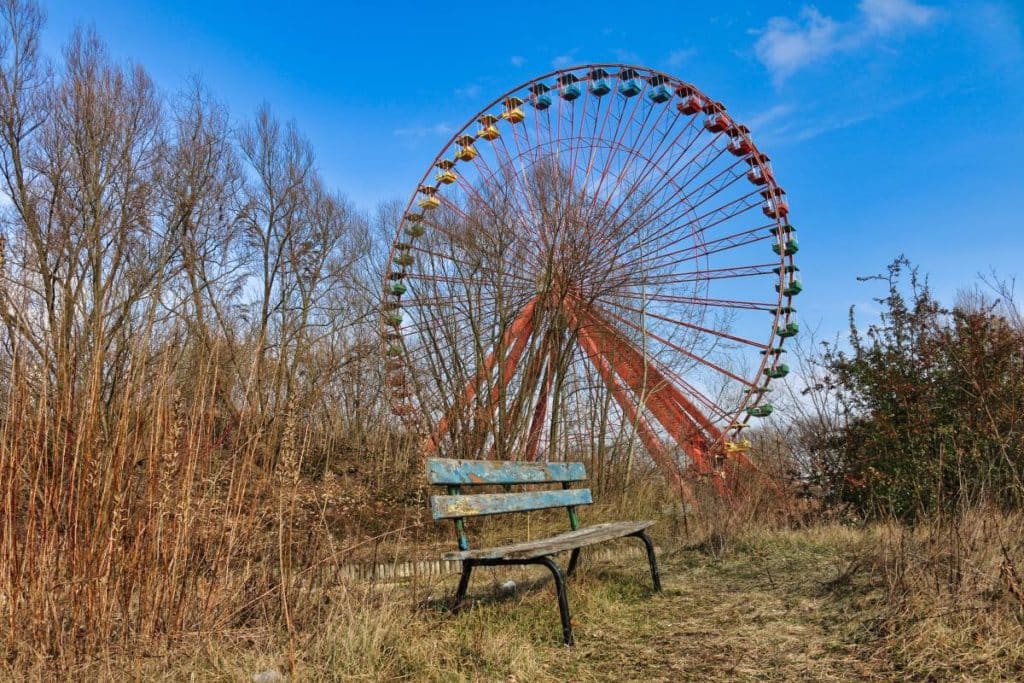
Plänterwald Cultural Park (later Spreepark)
Cultural Park Plänterwald was the only large amusement park in the GDR. It had the best and most original carousels in the country. The 50 or so attractions stood in the same place all year round – that alone was unique in the GDR. The Ferris wheel was the highest installation in the district. Unfortunately, since the fall of the Berlin Wall, the later Spreepark has gone downhill considerably. To this day, the city of Berlin is struggling to find a solution.
Stasi and surveillance
The Stasi was always and everywhere in the GDR. More than 180,000 of the 16 million GDR citizens were Stasi informants. In addition, there were the full-time employees whose task was to keep citizens under control and prevent “counterrevolution”. Accordingly, there were also some places in GDR Berlin that belonged to the Stasi.

Stasi headquarters
Once upon a time, Normannenstraße was the headquarters of the Ministry of State Security. The building housed all the departments of the secret service, which shadowed the lives of all GDR citizens and many targets of interest to them from the West. Even today, the office of the Stasi Minister Erich Mielke is preserved, from where he commanded the repression of GDR citizens. Exhibition and guided tours provide interesting insights into the work of the Stasi and the lives of its victims. An absolute must-see when visiting GDR Berlin!
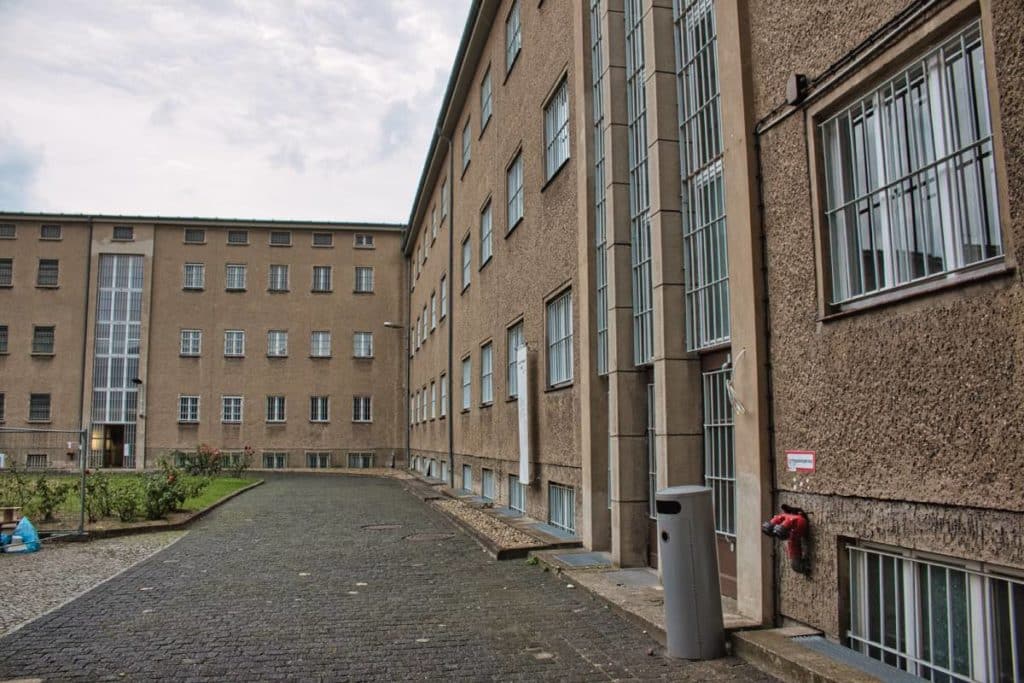
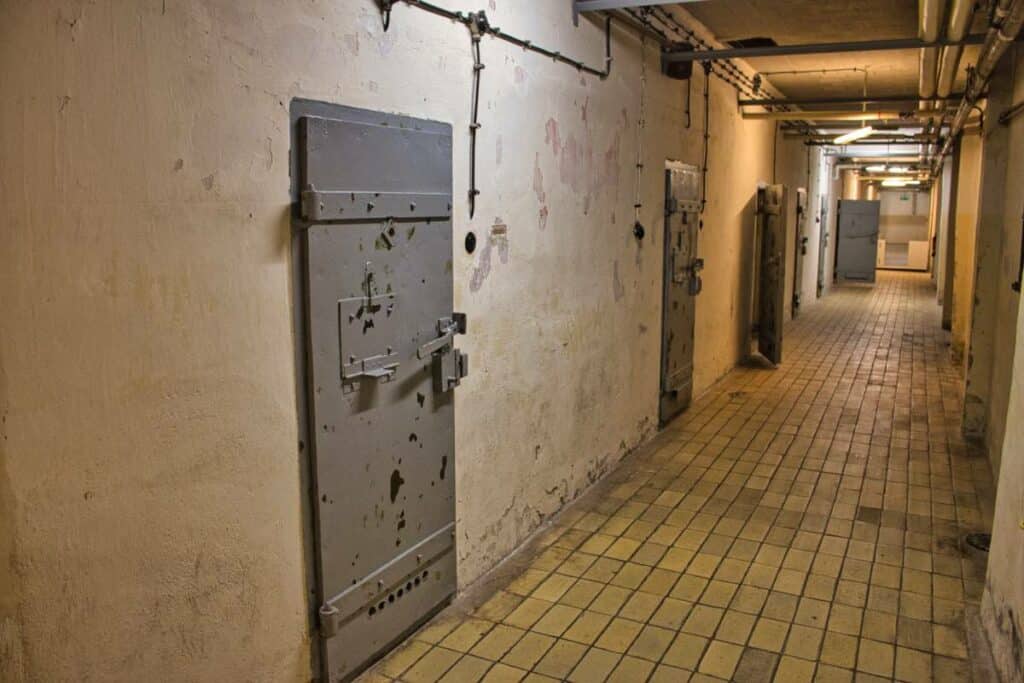
Hohenschönhausen Memorial
At the Hohenschönhausen Memorial, you can also see what happened to those who resisted the oppression of the socialist state. Many ended up in the Stasi’s pre-trial detention centers, where they were interrogated and tortured. The tour guides are former prisoners themselves and will tell you about their own fate and what happened to them at this place.
Memorials from GDR times in Berlin
The cult of the victims of fascism had a very high significance in the GDR. Thus, the leaders of the communist parties who were murdered by German fascists were honored with countless namings. Streets, squares, combines were named after them. And the soldiers of the Red Army, who had made a huge sacrifice for the liberation of Germany from National Socialism, were also honored with elaborate monuments and memorials.
Soviet memorial
In 1949, the Soviet Military Administration erected a memorial in Treptow for more than 7000 Red Army soldiers who died in the Battle of Berlin. Today, the memorial is still an annual gathering place commemorating Germany’s surrender in World War II on May 8, 1945 (May 9 in the Soviet Union). the ensemble is one of the few places where you can still see the hammer and sickle in East Germany.
Memorial of the Socialists in Berlin-Friedrichsfelde
All the great leaders of the (communist) workers’ movement and the GDR are commemorated at the Socialists’ Memorial. In addition to Karl Liebknecht, Rosa Luxemburg and Ernst Thälmann, the GDR greats Walter Ulbricht, Wilhelm Pieck and Otto Grotewohl, who died before 1990, are buried here. To this day, there is the annual Rosa Luxemburg demonstration, where participants from the left-wing party spectrum march up to the memorial and lay red carnations here to commemorate the anniversary of the assassinations of Rosa Luxemburg and Karl Liebknecht.
Museums about the GDR in Berlin
Of course, the GDR Berlin is also present in the museums. In no historical exhibition, which deals with the 20th century, it may be missing. In Berlin there are several museums that revolve around the GDR in Berlin.
GDR Museum Berlin
As a privately run museum, the DDR Museum Berlin enjoys great popularity. In the house not far from the former Palace of the Republic there is a comprehensive exhibition about everyday life in the GDR. The museum has a whole 45 thematic areas – the Wall, the Stasi, GDR products, housing and much more are presented. The museum is constantly expanding its collection and has a few real works of art like the mural “Lob des Kommunismus” (In Praise of Communism) by Ronald Paris in its inventory, a Trabant and much more. If you are interested in the GDR Berlin, you should definitely stop by here.
Museum at Kulturbrauerei – Everyday life in the GDR
A good alternative to the GDR Museum is the Museum at Kulturbrauerei. In the exhibition, everyday life in the GDR is presented comprehensively. Here you can also see many everyday objects from GDR times. In addition to kitchen products, mopeds and cars, you can also learn a lot about the repressive apparatus by Stasi and Co. or about the activist movements, the fighting groups in the factories and more. Unlike the GDR Museum, the museum in the Kulturbrauerei is under state management. Admission is free!
German-Russian Museum
The house of the German-Russian Museum is one of the fateful places, not only for Berlin architecture, but for all of Germany. Here, on May 8, 1945, the surrender document of Nazi Germany to the Allies was signed. It marked the end of the Second World War in Europe. In the following years, the building served as the headquarters of the Soviet Military Administration. Since 1994, it has been used primarily to commemorate the German-Soviet War and the surrender. However, special exhibitions also deal with many other topics.
Museum apartment WBS 70
WBS 70 was the standard model of East German prefabricated housing. A total of almost 650,000 apartments of this type were built. It was the most widespread type of prefabricated housing in the GDR. In Berlin-Hellersdorf, therefore, you can see a typical apartment of this prefabricated housing type. A total of 42,000 of these apartments were built in Hellersdorf. The museum apartment is the last original preserved example of a typical WBS 70 apartment. Here you can see not only the typical cupboard walls and wallpaper. There are even details like original salt and pepper shakers to see.
Stay overnight in Berlin in the GDR
Of course, there were hotels in the GDR. For locals and for guests. Not all of them survived the changes in Berlin. Nevertheless, some of the former GDR hotels still exist today. Of course with modern standard – or in the case of the East with intention without!
Former Interhotels, Hostels etc.
Interhotel Stadt Berlin – Park Inn Berlin Alexanderplatz
The central Hotel at Alexanderplatz* is the highest hotel in Berlin. From the sky suites you have one of the best views of the city anywhere. For the history see above.
Grand Hotel Berlin – Westin Grand
Today’s Westin Grand* has already been existing as Grand Hotel Berlin since 1987. Here you could only pay with US dollars or West German marks. The rooms were outrageously expensive for the GDR, but offered luxury that was otherwise almost unknown.
Domhotel – Hilton Berlin
The last hotel project of the GDR in Berlin was not even opened in GDR times. In 1990, the Domhotel* opened its doors. It later became the Hilton Berlin.
Ostel
Housed in a GDR prefabricated building near East Berlin’s former main train station (now Ostbahnhof), the GDR still seems alive at Ostel*. All rooms are decorated in pre-turnaround style with original antiques. You can even watch former GDR television on the TV. There are different room categories from rooms with shared bathrooms, private double rooms to a vacation apartment for up to 6 people.
Book recommendations
You want to learn more about the Berlin architecture or the past of the capital of GDR? Then get one of these books now!
- Harper Perennial
- brand: Harper Perennial
- manufacturer: Harper Perennial
Book about the history of GDR’s state security and how everyday life in East Berlin looked like.
- Hertzberg, Max (Author)
Spy novel about East Berlin
The renowned architectural publisher dom Publishers has, among other things, a book in its program dedicated to the Berlin. Many historical photographs round off the well-researched book.

